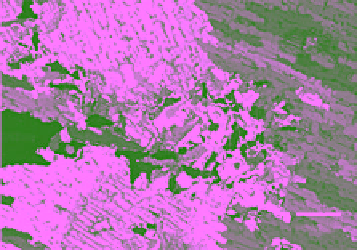Geology Reference
In-Depth Information
(a)
(b)
5 mm
10 mm
Figure 4.19
Double‐microtomed (DMT) horizontal thin section of first‐year S2 type sea ice at 0.25 m depth
obtained from Eclipse Sound in the Arctic showing a brine drainage channel in the (a) center of the micrograph
with details of (b) the core area of the channel (N. K. Sinha, unpublished).
the ice thickness was 0.25 m. The differences in the intra-
granular characteristic in freshwater ice and sea ice are
significant. While grains of freshwater S2 ice look clear
and grain boundaries are linear, grains of the same type
of ice from the sea are translucent and exhibit complex
substructures and brine inclusions.
Similar to freshwater S2 ice, the conditions for the for-
mation of S2‐type saline ice can be simulated well under
laboratory conditions. Thin layers of reasonably accept-
able ice up to a thickness of 0.25 m can be grown. In fact
many studies on the mechanisms of brine drainage in
saline S2 ice are based on laboratory observations. The
laboratory studies are, however, complicated by artifacts
imposed by the limited area and depth of experimental
growing tanks. Moreover, nothing can replace the natu-
ral conditions for developing columnar‐grained S2‐type
sea ice. Natural ice provides the only opportunity for the
observation of brine drainage channels in nature. An
example is shown in Figure 4.19. Here the ice core was
sampled from an ice cover in the southern part of Eclipse
Sound where the ice was found to be S2 type. The coring
was performed with the intention of capturing a verti-
cally oriented brine drainage channel in the middle of
the core. The location of the main passage of the brine
channel and the orientation of its major tributaries tend
to show that the interconnected subgrain boundaries
must play the major roles in the desalination processes.
These channels are eventually filled by water percolating
from the top and refreezing inside the open spaces of the
channels. This actually can be seen near the core of the
brine channel in Figure 4.19a with details at the center
shown in Figure 4.19b. This picture and the descriptions
provided here may help in understanding the brine drain-
age mechanism through subgrain boundaries in sea ice
discussed earlier in section 2.3.3.2 and illustrated in
Figures 2.33 and 2.34.
4.3.3.5. Columnar‐Grained Ice with
c
‐Axis Horizontal
and Oriented (S3) Ice
While working on the actions of sea ice on the newly
constructed wharf at Nanisivik, Baffin Island, Canada,
in 1975,
Frederking and Sinha
[1977] noticed preferred
c
‐axis orientation of columnar‐grained ice in the horizon-
tal plane and parallel to the direction of relatively strong
tidal current in Strathcona Sound. This alignment was
also confirmed later for sea ice in Eclipse Sound, Baffin
Island, Canada, by
Nakawo and Sinha
[1981, 1984] who
provided details of fabric diagram, texture, and subgrain
microstructure, such as the brine layer spacing as func-
tions of depth and the growth history. However, the most
comprehensive confirmation of the relationships between
the preferred
c
‐axis orientation and the direction of cur-
rent in the water under the ice came from the investiga-
tions of
Weeks and Gow
[1978, 1980] off the northern
coast of Alaska. They performed an extensive survey of
sea ice structure along the coasts of the Beaufort and
Chukchi Seas and concluded that the degree of orienta-
tion is more visible as the depth of the ice sheet increases.
Moreover, the preferred orientation generally parallels
the coastline or the narrow channel in which ice is grow-
ing. Beyond any doubt, they established the link between
the orientation and the water current under the ice. They
explained this phenomenon based on a hypothesis that
ocean current flow reduces the salinity of the seawater in
the direction of the current. This makes crystal growth
favored in that direction as they can extend easily farther
into the melt than neighboring crystals that face “resist-
ance” for their growth from the higher salinity solute.
The columnar‐grained sea ice with preferred orienta-
tion of
c
axis of the grains in the plane normal to the long
axis of the grains is classified as S3‐type of ice (Table 4.1).
A schematic diagram for S3‐type columnar‐grained sea
ice with preferred orientation of the
c
axis in the horizontal


